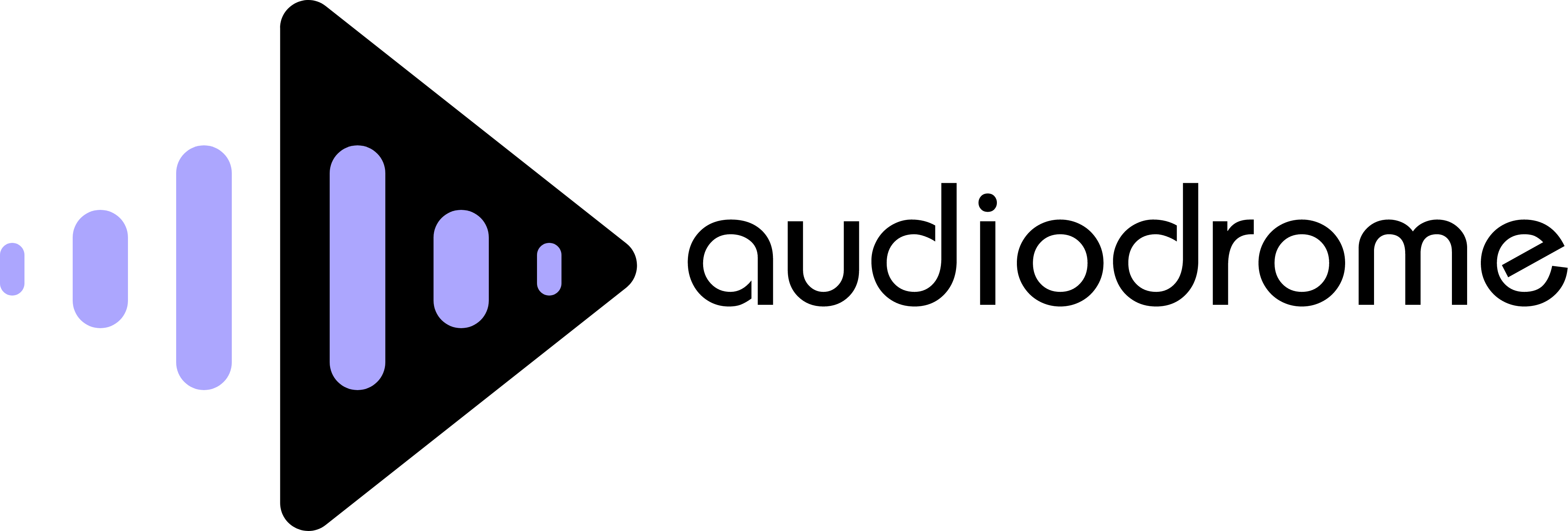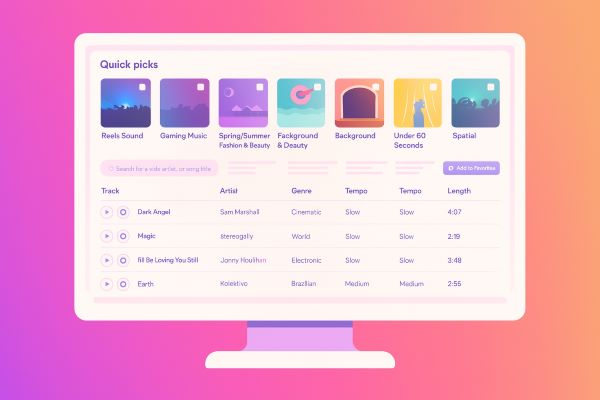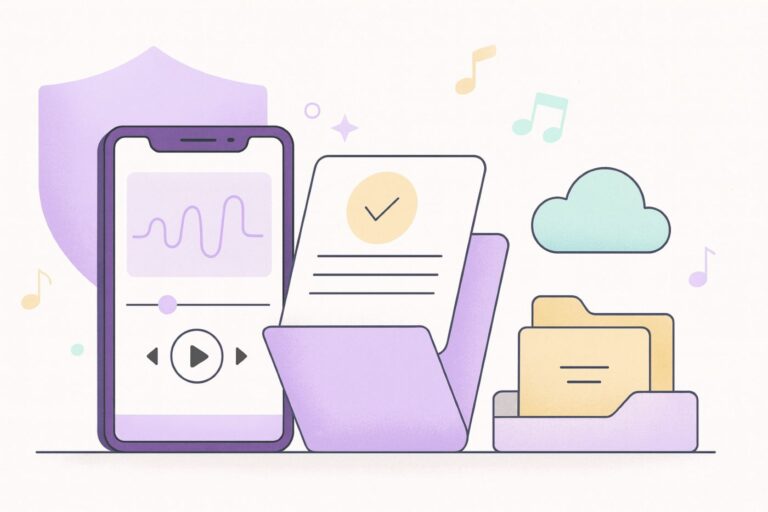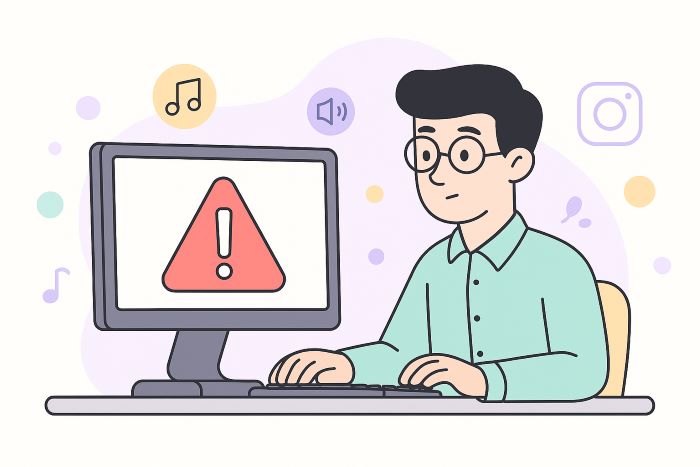How Public Domain Music for Podcasts Really Works and How to Prove It Safe
Audiodrome is a royalty-free music platform designed specifically for content creators who need affordable, high-quality background music for videos, podcasts, social media, and commercial projects. Unlike subscription-only services, Audiodrome offers both free tracks and simple one-time licensing with full commercial rights, including DMCA-safe use on YouTube, Instagram, and TikTok. All music is original, professionally produced, and PRO-free, ensuring zero copyright claims. It’s ideal for YouTubers, freelancers, marketers, and anyone looking for budget-friendly audio that’s safe to monetize.
Public domain music feels like a cheat code for podcasts until a claim hits your inbox. The catch is that “old” does not always mean free. This guide shows you how to check compositions, recordings, and proof so your intros and beds stay safe.
Public domain ≠ “any old music”
When you talk about public domain music, you need to separate the song from the recording. The composition can sit in the public domain while a label still owns the recording you want to use. For podcast music, you always check both layers, or you risk treating protected audio as if it were free.

Public domain rules also change from country to country, which adds another trap. One territory might free a composer’s work while another still treats it as protected. For podcasting, you pick your key territories, like where you publish and where most listeners sit, and you check public domain status against those laws, not a vague global idea.

You also need to understand the difference between the public domain and CC0. With CC0, a rightsholder gives up their rights and tells you that you can use the work freely, which you still document and keep as proof. With the public domain, the law lets the protection expire, so you rely on dates and ownership rules, which you explore in Podcast Music Copyright and Creative Commons for Podcasts.
When is it actually PD for podcast use?
Use this quick matrix at a glance, then go through the details and sources in the rest of the guide. Public domain music for podcasts looks simple on the surface, but each asset carries its own mix of dates, owners, and terms. The same piece can feel completely safe on paper and still cause trouble if you pick the wrong recording or trust a vague “PD” label online.
| Asset | PD status likely? | Safe for editing? | Business / sponsored use? | Proof to save |
|---|---|---|---|---|
| Composition published long ago (score / lyrics) | Often yes once the composer has been dead long enough under local law, but you still check death year and term in your key territories. | You can create, record, and edit your own performance with wide freedom when only the composition sits in the public domain. | Yes, business and sponsored podcasts can use new recordings of a public domain score when they also clear or own the recording rights. | Composer life dates, publication data, and a reliable public domain reference that matches your target country. |
| Modern recording of a PD composition | The composition may be public domain while the recording usually stays protected until its own term runs out. | You only cut, loop, or mix this track when you hold a license or a clear CC0 or explicit permission from the recording owner. | Treat this as licensed music for brands, sponsors, and ads unless you have a written grant that covers commercial podcast use. | License agreement, CC0 statement from the creator, or contract that names your show and allowed uses. |
| Historic archival recording | Sometimes both composition and recording age into the public domain, but you need to confirm dates and any special archive rules. | Many archives let you edit and restore audio, yet you read their terms before you build intros, beds, or heavy processing. | Some archives allow commercial reuse, others limit it, so you check their policy before you place the track in a sponsor message. | Archive catalog page, public domain or reuse statement, and screenshots that show conditions and dates. |
| “PD” track found on YouTube or a stock site | Status stays unclear until you trace the track back to the original composer, recording owner, or trusted library. | You do not treat it as safe for editing until you confirm both composition and recording rights beyond a vague title or tag. | High risk for business, sponsored, or agency shows, even when the upload claims public domain without proof. | Original catalog or creator page, not just the platform listing, plus any written permission you receive. |
| CC0 release by the creator | Not public domain by expiry, but the creator waives their rights so the track behaves like a very open public domain style asset. | Yes, you can trim, loop, mix, and repurpose under CC0, which invites wide reuse across your podcast formats. | Yes, commercial and sponsored use usually fits, as long as the CC0 grant covers the recording you actually download and use. | Screenshot of the CC0 statement with track title, URL, and date, plus a copy of the file you used. |
Verification workflow (step-by-step)
Use this workflow every time you rely on public domain music for podcasts, so you know exactly what you use, why you trust it, and how you can defend it if a platform questions you later.
Define the asset
Clarify if you use the composition, recording, or both.
Identify the composition
Note composer, work title, and first publication date.
Identify the recording
Capture performer, label, release date, and catalog ID.
Confirm source authority
Prefer official archives, creator sites, and trusted libraries.
Scan for encumbrances
Check for samples, new editions, restorations, or added rights.
Decide on use
List podcast, trailers, socials, and any video versions.
Capture proof
Save screenshots, URLs, dates, and any PD or CC0 notes.
File in your Proof Pack
Tie everything to show, episode, air date, and timecodes.
Define the asset
Start by writing down what you actually want to use. Is it only the composition on paper, or a specific sound recording, or both together in your episode? When you split the asset this way, you stop treating “music” as one big block, and you can check rights on each layer with much more control.
A musical work means the song itself, not any specific performance. Think of the melody, harmony, lyrics, and structure as they appear in a score, lead sheet, or lyric document.
%201.jpg)
A recording means a specific captured performance that you can play as a file, stream, CD, or vinyl track. It includes the exact take, sound, mix, and timing that a band, label, or studio released.
%202.jpg)
Identify the composition
Next, pin down the composition itself. Note the composer’s full name, the work title, and the original publication date from a reliable catalog or reference. Then check if that song counts as public domain in your key territory or territories, because a piece that looks free in one country might still sit under copyright in another.
%203.jpg)
Identify the recording
Now move to the exact recording you plan to drop into your podcast. Capture the performer or ensemble, label, release date, and any catalog or ID numbers from the source. With that information, you can check if this recording has aged into the public domain, carries a CC0 grant, or still needs a license before you cut it into your show.
%204.jpg)
Confirm source authority
You then look at who actually provides the file. An official archive, creator site, or recognized library gives you a much stronger base than a random re-upload on YouTube. If you cannot trace the track back to an authoritative source, treat the “public domain” label as marketing rather than proof and keep looking.
%205.jpg)
Scan for encumbrances
Even when dates appear safe, you still scan for additional hooks that can create rights. Listen and read for samples, new arrangements, and heavily restored versions that add fresh copyright on top. If a label or publisher calls a release a new edition or remaster, you treat that as its own protected recording and adjust your plan.
Decide on use
With composition, recording, and encumbrances clear, you decide how far you want to take this asset. Using it once as a quiet bed in a single episode carries a different risk than building it into trailers, social clips, and video versions. Make sure the public domain status or license you rely on covers every destination and format you plan to use.
%207.jpg)
Capture proof
Once you feel comfortable, you collect proof while the pages still match what you saw. Take screenshots of catalog entries, public domain or CC0 statements, and any creator notes that mention reuse or commercial permission. Add the full URLs and the date you captured them so you can show what the source looked like if anyone challenges you later.
%208.jpg)
File in your Proof Pack
Finally, drop everything into a simple Proof Pack so you can find it in seconds. Note the show title, episode number, air date, permalink, and rough timecodes where the music appears, then attach your screenshots and files. When a platform, client, or sponsor asks how you cleared that beautiful classical music in your podcast, you have your PD music proof ready to send.
Composition PD vs Recording PD (what you can & can’t do)
When the composition sits in the public domain, but you hire musicians or buy a fresh studio recording, you unlock two different routes. You can perform and record your own version of the piece without paying composition royalties, then keep full control of that recording. Or you can license an existing recording and treat it like any other cleared track for your podcast.
%201.jpg)
If both the composition and a specific archival recording are in the public domain, the door opens wider for podcast use. You can drop that historic performance into intros, story moments, and credits, as long as you credit clearly and do not confuse listeners about who performed it. You still read the archive terms of service and make sure they allow download, editing, and commercial use.
%202.jpg)
Sometimes the composition does not fall into the public domain yet, but the creator or label releases a recording under CC0. This situation remains rare, but it matters for podcasters because CC0 lets you use the recording freely, even in business or sponsored shows. When you rely on this kind of public domain style grant, you save a clear copy of the CC0 statement as part of your PD music proof.

Arrangements and new editions sit in their own risk zone and deserve extra care. A modern arranger can add fresh copyright on top of an old melody, and a new engraved score or heavily reworked version can also carry rights. Before you treat a dramatic arrangement as public domain music for podcasts, you track who created that version and confirm if you need permission for the new creative work.
What proof to keep
Treat your public domain music proof like a small legal kit for each track. Save the source URLs with the date you checked them, screenshots of PD or CC0 statements, catalog numbers, and clear composer and performer details. Add the actual audio file you used, a simple waveform or file hash, and short notes on how you trimmed, mixed, or EQ’d it.
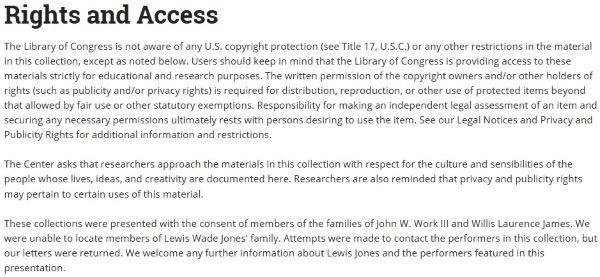
Then give that kit a home you can find later in seconds. Create a show-level folder, add a Proof subfolder, and file each piece as PD with the work title, version, and date in the name. If you work for clients, include a one-page PD Verification Sheet inside that folder with links to your sources so they can show their own lawyer or platform if needed.
Scenario quick answers (what’s safe / what’s risky)
Use these quick scenarios to stress test your plan before you drop public domain music into a real episode, trailer, or campaign.
Theme/Intro using a famous classical work
If you want a big classical theme, the safest path is to use a public domain composition and record your own performance. That might be a simple home recording, a focused studio session, or a commissioned arrangement that fits your brand. In that case, you own or control the recording rights and avoid mystery claims from unknown labels.
Another option is to use a recording that clearly sits in the public domain or carries a CC0 grant, with proof to back it up. Save catalog entries, PD statements, or CC0 pages that name the exact track you downloaded. When a platform flags your classical music in podcasts, you can answer with clean documentation instead of guesswork.
Background bed from an “old record”
When you want a lo-fi bed from an old record, you check the age and rights on the recording, not just the mood. A scratched jazz or swing track might sound ancient, but still sit under a label contract. You only treat it as public domain music for podcasts after you confirm both composition and recording dates in your key territories.
You never rely on the upload date on YouTube or a file added last month to a stock site. Instead, you look for catalog numbers, original release dates, and a clear PD statement from a library or archive that you trust. If you cannot find that trail, you pick a different source or move to licensed or royalty-free options.
Trailer/social cut-downs of a PD recording
If you pull a public domain recording into a trailer or social clip, you check that the status still holds on every platform you plan to use. Some services act strictly around Content ID and ask you to prove that both the composition and the recording sit in the clear. You avoid surprises by mapping destinations first and choosing tracks that you can travel with you.
You also treat each cut down as part of the same audio family and keep the proof close to your marketing assets. Mention the source briefly in your press kit or show deck and keep your PD or CC0 screenshots in the same folder as your artwork. When a distributor or ad partner asks how you cleared the music, you already have the story and the files.
Sponsored/brand podcasts
For a sponsored or branded podcast, public domain music can work well as long as you treat it with the same care as licensed tracks. You confirm that the recording itself is truly public domain or clearly released under CC0 and that any archive or library terms allow commercial, promotional, and advertising use. That way, you protect both your show and the brand that pays for it.
Client asks for “1920s vibe”
When a client wants a 1920s feel, you do not need to gamble on random vintage uploads. You can choose a public domain composition from that era and book a new recording that nails the style while keeping rights clean. Or you can use a royalty-free library that offers vintage-inspired tracks, which you manage through the licensing paths you outline in Podcast Music Rights.
PD or license?
When you want a vintage sound for your podcast, you start with the composition. Check that the songwriter and work now sit in the public domain in your key territories. If the song still falls under copyright, you switch to licensed music or commission a new piece instead of forcing it into a PD box.

If the composition qualifies as public domain music for podcasts in your territory, you move your attention to the actual recording. Ask yourself if you own the master, trust the library, or know the label that released it.If you cannot answer yes with confidence, create your own recording or use a royalty-free or commissioned track with clear written terms.
Then you look at where the audio will travel. If you plan to publish on social platforms or YouTube, you should document and save any public domain or CC0 status before launch. If you cannot build that proof, you pick a licensed track that covers every platform and monetization channel you care about.

What are the other music options for podcasts?
Public domain music helps in some cases, but you still need other routes when you want modern sounds, chart songs, or quick, clear answers for clients and sponsors.
Creative Commons
Creative Commons music can work when you understand the exact license on each track. Some licenses allow commercial shows and edits, others block ads or remixing, so you read every condition, not just the logo. For podcasters, CC BY and CC BY 4.0 style licenses usually give the most flexible path when you credit correctly.

Direct licenses for popular songs
If you want a well-known song, you move into direct licensing. That means clearing both the composition and the master recording through publishers, labels, or specialist licensing services. This route costs more and takes more time, but it lets you use the real track your listeners know instead of a sound-alike.

Commissioned original music
Commissioning original music gives you a custom sound that fits your show and brand from the first note. You agree in writing that your studio or client owns or controls the track for podcast, social, and video use. Once that agreement sits in place, you can reuse the theme, stems, and edits across seasons without fresh paperwork each time.
.jpg)
Royalty-free / production music libraries
Royalty-free and production libraries sit between custom work and pop songs. You buy a license that covers a catalog of tracks for podcast episodes, trailers, and sometimes social cut-downs as well. The key is to read the allowed uses and track which shows, networks, or clients sit under each license, so you do not stretch it too far.






FAQs
These answers sit under the real questions you see in the screenshots, so readers can connect their worries with clear next steps.
Where can I find public domain music for my podcast?
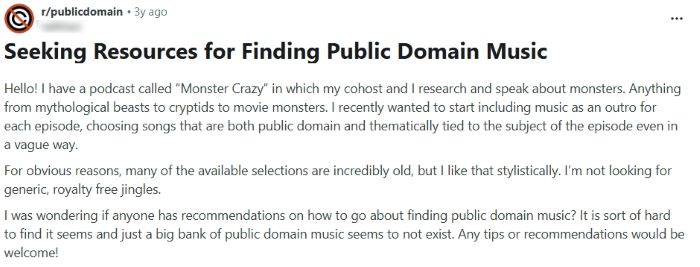
You find reliable public domain music by starting with trusted catalogs, national libraries, and specialist PD or classical archives, not random blogs. Look for clear statements about the composition and the recording, plus catalog numbers you can screenshot for your PD music proof. When a track feels hard to trace, you move on instead of forcing it to work.
Is there any actually free podcast-safe music?
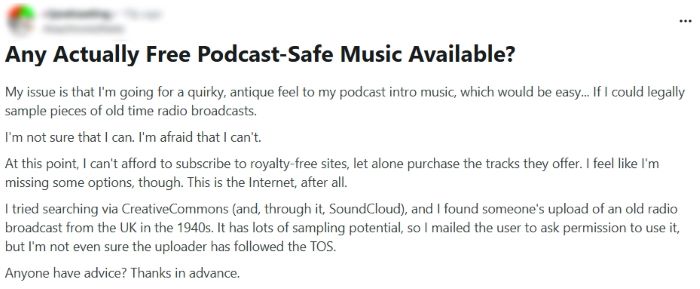
If you want an antique or quirky feel, you look for public domain compositions and recordings that list dates, performers, and sources. When that fails, you pivot to CC0 releases, carefully chosen Creative Commons tracks that allow commercial use, or royalty-free libraries. The goal is not just free music, but music you can defend when a host asks questions.
I used “public domain” music and still got a copyright claim. What now?

If a track from a public domain site still triggers a claim on YouTube, that usually means the recording or upload path is unclear. You respond by checking that the composition is PD, tracing the recording back to its source, and gathering solid proof in your Proof Pack.If you cannot verify both layers, you swap the track before the next episode.
Is Pixabay a safe source of free music for podcasts?

Sites like Pixabay can help, but you still have to read the license page for each track and save it with your notes. Check that the license covers podcasts, commercial use, and posting on platforms like YouTube and social video. When you want long-term safety, you treat these tracks like any other asset and keep proof with your episode files.
Use the public domain with a clear plan
Public domain music works best when you treat it as a clear plan, not a lucky guess. Check the song, check the recording, and save proof every time. With that habit, you can use classical music in podcasts with confidence and buy licenses only when you truly need them.

Audiodrome was created by professionals with deep roots in video marketing, product launches, and music production. After years of dealing with confusing licenses, inconsistent music quality, and copyright issues, we set out to build a platform that creators could actually trust.
Every piece of content we publish is based on real-world experience, industry insights, and a commitment to helping creators make smart, confident decisions about music licensing.

